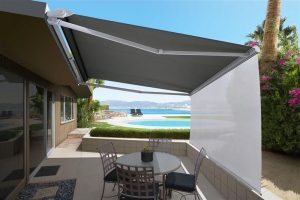An awning is a decorative extra that is often added to the outside wall of a commercial building. It’s commonly made of canvas woven of nylon, cotton, polyester or terylene yarn, or vinyl coated to vinyl. Today’s awnings can be used for various purposes, such as retractable awnings, fixed-over awnings, overhangs, deck covers, and more. The purpose of an awning depends on the application. For example, awnings can be attached to the top of a building to shield it from rain, sun, and snow.
Awnings have been around since the 19th century, but they were initially designed for practical purposes only. Back then, the awnings were used for ventilation in textile mills. Awnings are usually made up of two components: the awning fabric and the awning frame. Fabric is the main component of an awning, while the awning frame is made up of various materials such as canvas, aluminium, wood, steel, and fibreglass.
 Awnings provide shade from direct sunlight. The awnings are attached to buildings on their top floors or their sides so that the awnings obstruct the direct sunlight from the windows. In addition, awnings provide protection against wind, rain, snow, and hails.
Awnings provide shade from direct sunlight. The awnings are attached to buildings on their top floors or their sides so that the awnings obstruct the direct sunlight from the windows. In addition, awnings provide protection against wind, rain, snow, and hails.
Not many people realise that awnings South Australia are commonly used on commercial buildings in all weather conditions. However, a few types of awnings are specifically designed to provide shade in particular weather conditions. Awnings available in the market are fabrics like linen, canvas, terry cloth, and acrylic. In addition, awnings that provide UV protection are commonly used on the porch and verandas.
Awnings have been used for almost one thousand years in both human and animal cultures. In the early 19th century, awnings started providing shade and protection to buildings, homes, gardens, town squares, and workshops. The awnings were hung from the buildings to prevent heat from entering the building. The awnings, as well as roofs, were replaced by metal railings. Awnings are protected against the sun by shading buildings.
Awnings provide shade to a home or a commercial building by allowing filtered light to enter the building. Awnings are usually placed on the windows to filter the sun rays before they enter the interior. Awnings also provide shade to a house by providing sunblock, especially on sunny days. Awnings on the front door provide shade to a home or business to prevent potential intruders from entering the property.
Awnings are available in a variety of sizes and shapes. They can be constructed out of wood, vinyl, glass, or aluminium. The material of the awnings should match the composition of the building facade so that it performs its function effectively. Retracted awnings are best suitable when there is inclement weather. The retractable model is designed to overlap the opening between the patio or veranda roof and the building facade so that rainwater and snow do not accumulate on the awning.
In addition to providing shade, awnings also protect the interior part of a house from direct sunlight. The most common materials used for constructing awnings are canvas and wood. Canvas is a waterproof fabric that is commonly used for draperies, screens, and window coverings. On the other hand, wood is a more appropriate material for constructing an awning because it is a much stronger material than the previously mentioned material. Nowadays, one can find both retractable and arm awnings that can be installed on houses.